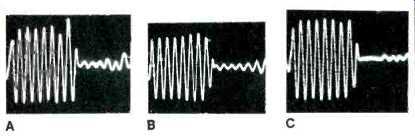
MANUFACTURER'S SPECIFICATIONS
Bass unit: 10 inch, high compliance.
Midrange: 5 inch.
Treble: 9-2 ½-inch, closed back type.
Frequency response: 30 to 15,000 2 dB.
Crossover points: 800 Hz and 1500 Hz.
Size: 22 inches diameter, 30 inches high with pedestal.
Weight: 45 lbs.
Price: $325 each.
Some speaker designers believe a pulsating sphere to be the ideal type of reproducer and there is no doubt that the D-12 comes near to that concept. It is actually a twelve-sided system-a dodecahedron and a total of 11 speakers are used.
The bass unit is a 10 inch type and it faces the floor. A 5 inch mid-range speaker faces upward and 9 treble units are mounted on the sides or facets. These are 2 1/2 inch cone types having closed backs. The enclosure itself is a reflex with a tube vent tuned to 27 Hz. System resonance is 43 Hz.
Terminals with shorting links enable the high frequencies to be attenuated and a similar arrangement inserts a resistor in series with the bass unit-as well as a parallel resistor to maintain damping. This is an unusual feature but very much worthwhile as the bass may be over-emphasized in some corner locations. The enclosure is very well made with an attractive stand which is available in black steel or chromium plate. There is also a choice of four grille cloths-avocado, gold, mandarin or ivory. There is also provision for suspending the units from a ceiling and the enclosure can be had in standard walnut, black or white lacquer finishes.

---Design Acoustics D-12 Loudspeaker System
Measurements

Fig. 1--Frequency response taken with one-third octave pink noise. A was measured
on a horizontal axis and B at 30 degrees off vertical. The dotted curve at
A shows the effect of the high frequency attenuation adjustment.
Figure 1 shows the frequency response measured with one-third octave pink noise. A was taken on a horizontal axis and B at 30 degrees off the vertical axis. The dotted curve at A shows the effect of the high frequency attenuator. Ten other measurements were taken and, as expected the variations were quite small. Figure 2 shows the low frequency THD and some SPL figures. The system would take an input of 37.5 watts, continuous power, at 40 Hz without distress, 99 watts at 60 Hz and 133 watts at 100 Hz. Tone-burst responses at 100, 1,000 and 5,000 Hz are shown in figure 3.
Figure 4 shows the impedance characteristics and it will be seen that the lowest point is about 5 ohms. The peak at system resonance falls from 45 ohms to 8 ohms when the bass attenuating network is used (see lower curve). White noise indicated a slight coloration in the lower midrange--not judged serious.

Fig. 2--Low frequency THD and some SPL figures.

Fig. 3--Tone-burst responses. A is 100 Hz, B 1,000 Hz and C 5,000 Hz.

Fig. 4--Impedance characteristics. The lower curve shows the impedance with
the LF link removed.
Listening Tests
The subject of omni-directional versus directional radiation was dealt with at some length in our March issue. It is sufficient to say here that experts do not agree as to the best dispersion pattern for domestic listening. Omni-directional speakers have the merit of giving a larger listening area at the price of a more diffused stereo image. This is partly due to the random reflections and so extra care is necessary in finding best positions in the room--especially for quadraphonic sound. We found the best places for the D-12's was near the corners, immediately in front of some heavy drapes; this way we had a good stereo image without losing a sense of spaciousness. Overall sound quality was excellent with a solid bass and smooth treble. Some organ recordings were played-including a new Power Biggs "Organs of Holland and Northern Germany" and a record called "Organ Music from Westminster" (The Westminster is the Presbyterian Church in Minneapolis and the organist is Dr. Berryman). There was no doubt that the bass response is well maintained considering the relatively small size of the enclosure.
Sensitivity is about average--which means an amplifier of at least 20 watts per channel is required. We used a Pioneer 727 which puts out 50 watts per channel--also a Fisher 504 which delivers a total of 180 watts. Both gave more than adequate power for a fairly large room.
Summing up then: the Design Acoustic D-12 can be recommended to the attention of those who require a system with better than average performance and particularly to those who like a spacious kind of sound. But be prepared to experiment to find the best room positions.
-T.A., G.W.T.
(adapted from Audio magazine, Apr. 1973)
Also see:
Dynaco A-25XL Loudspeaker (Equip. Profile, Nov. 1976)
University "Project M" Speaker System (Apr. 1970)
Electro-Voice Interface:A speaker (Mar. 1976)
Dynaco AF-6 AM/FM Tuner (Equip. Profile, Sept. 1974)
Dynaco Stereo 70 Series II Tube Amp (Nov. 1992)
= = = =